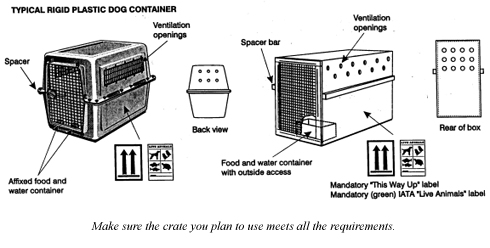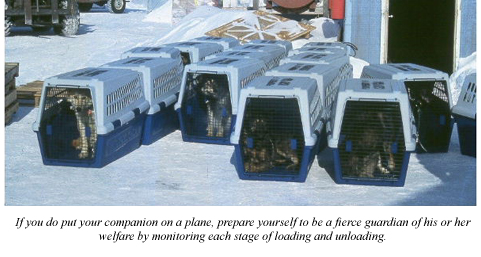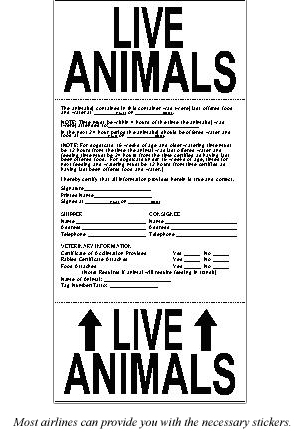


Christmas Store
The holidays are just around the corner so now is the time to fetch the finest gifts for the Labrador Lover on your Christmas list. We have over 100 gifts $50.00 and under. Visit our Christmas Store.
For the Lab
Bedding
Coats
Collars and Leads
Dog Bowls
Feeding Stations
Spa and Grooming
Toys and Treats
Travel and Accessories
For the Lab Lover
Apparel
Cards and Giftwrap
Fine Accessories
Gifts and All Occasions
Jewelry
Kids Only
For the Lab Home
Artwork
Books
Garden and Outdoor
Home Furnishings
Kitchen Accessories
Pillows, Throws, and Rugs
Gift ServicesGift Boxes
Gift Certificates
Jet Set Pet
By Ellen English

Although thousands of pets and other live animals are shipped by air every year, it is at best highly stressful and at worst, a deadly mode of transportation. According to Tufts University, “although about 500,000 animals travel by air each year, 5000 a year either die, are lost, or are injured.” Better to avoid it if at all possible and never ship ill, very nervous, pregnant, or older pets by air. Many breeders have discontinued shipping puppies via plane because of unsatisfactory conditions and handling practices. If you’re considering taking your Lab on vacation by flight, weigh heavily the benefits vs. risks. Your four footed family member might well vote to stay home with a reliable sitter or to stay at a great kennel rather than be subjected to the many uncontrollable variables of plane travel.
If you’re relocating via plane, consider specialized ground transport services to move your dog to his new home or enlist the aid of services that assist with plane travel for pets, especially if you’re not accompanying your dog. Some airlines require the use of “known” carriers or professional shippers which are registered with the federal aviation authorities. Associations such as IPATA and AATA can connect you with professionals who can make all transportation arrangements for your dog including safe crating. Increased airline security has placed more restrictions on pet travel such that some airlines require that your dog be accompanied by a ticketed passenger. Visit the AKC ‘s Airline Policies Chart for more details on specific airlines.

If it is essential that your Lab fly, do your homework! Even though airlines have policies and government regulations to follow, it is your responsibility to take the necessary precautions to safe guard your Labrador. Domestic travel is complicated enough but international travel is truly tricky. Quarantine laws as well as a host of other regulations differ in each country. You will need to contact the consulate or embassy for your destination. Also check out Pets on the Go for a more detailed list of questions, but quarantine and International Health Certificate requirements are just two of the many issues you’ll need to research. The Pets Travel Scheme (PETS) is the new system that allows pet animals from certain countries to enter the UK without quarantine as long as they meet the rules.
The latest trend in plane travel for pets is airline service designed especially for transporting animals. Companion Air’s motto is “Where pets and their families fly first class.” They hope to make their inaugural flight soon so keep checking their site for updates.
Know before you go:
Even with extensive state, national and international animal transportation regulations, each airline establishes its own policies making it essential that you check with the air carrier you intend to use!
-
Determine in which compartment (or “hold”) on the plane your dog will be traveling. Conditions vary and even with regulations regarding pressurization, ventilation and climate control, it’s wise to learn what you’re exposing your dog to. Basically there are 3 choices: “carry-on” allows you to bring the carrier in the passenger cabin (if your Lab pup weighs less than 15 pounds and its carrier fits under the seat- although a few small local airlines allow larger dogs in crates to travel in the cabin as well.) “Checked baggage” means your dog will be located in the baggage compartment (available only if you’re traveling on the same flight) and will generally receive a priority level of service as opposed to cargo shipments. “Cargo” service means that your Lab will be shipped with other freight (usually for unaccompanied dogs.) Some airlines have priority shipping options (sometimes called “premium” or “express”) that give expedited handling to your dog’s crate. These options usually cost more and may have size or weight restrictions but are well worth investigating. Some airlines have special pet shipping programs-such as Northwest Airlines “Priority Pet Program” and Continental’s “Pet Safe” program-that are designed to manage the process as safely as possible.
-
The location (passenger terminal vs. air-freight terminal for example) and time for drop-off and pick-up of your dog. Some terminals do not allow animals inside the terminal buildings.
-
Research possible temperature variations between departure and destination points and consider a flight schedule that minimizes temperature extremes. General rules of thumb: fly at night during hot weather and in the day during cold weather. When temperatures are moderate, consider flying early in the day when unexpected flight delays are less frequent. Try to book a non-stop, or “direct”, flight if at all possible.
-
Get specific crate/kennel requirements so that you can acquire the proper type and have time to condition your Lab to it. See the crate checklist below. If transporting your Lab pup via carry-on, be sure to get the under seat measurements for the airplane you’re scheduled to fly. Generally under seats carriers must be no larger than 17”L x 16” W x 10 ½” H.

Prepare to go:
-
Reserve a space for your dog well in advance (seems obvious but remember that each airplane can transport only a limited number of animals per flight.) Even with this done, many airlines will not confirm your dog’s reservation until a few days ahead to allow for more accurate weather reports.
-
Buy their ticket: different rates will apply for the various methods of shipping and you may even be charged for your carry-on companion. Consider insurance since it may provide your dog additional attention during his trip. Also, if temperature or weather changes prohibit your dog from flying, you may want to purchase a refundable ticket.
-
Have a back-up plan including someone who could come and pick up your dog should they be barred from flying.
-
Schedule a nonstop or “direct” flight, avoiding connections and the heavy traffic of a holiday or weekend flight.
-
Condition your Lab well in advance to the crate/kennel in which it will be shipped.
-
Locate an American Animal Hospital Association (AAHA) accredited hospital for your destination in the US or Canada and for each lay-over or connection along the way. The AAHA site also includes an index of pet first aid.
-
Add temporary tags to your dog’s collar for the destination contact info. Take extra blank (write-on)ones with you for unexpected changes in plans. For international travel, consider making a tag in the language of your destination. Do not use a choke collar or muzzle on your dog during travel. A harness or break-away type collar may be the safest option.
-
Pack a photo of your Lab in case he or she is lost and you may also want to attach one to the crate.
-
Pack a bag for your Lab with extra leashes and all the things you’ll need at your destination- such as doody bags for picking up after your pal.
-
Have a licensed veterinarian examine your dog within ten days prior to shipment and issue a Health Certificate stating that your Lab is in good health. Be aware-if your trip is scheduled to last more than 10 days, your Lab may need another exam by a vet located near your destination in order to qualify for the return flight home. Also, if you use a reduced vaccination protocol, discuss the vaccination reporting portion of the Health Certificate with the examining vet. Check the airline’s requirements for handling of the Health Certificate: you may need to carry it with you if your pup is traveling as carry-on but you will need to attach it (or a copy of it) to your Lab’s crate if it’s transported in the baggage or cargo hold.
-
Do not administer sedatives or tranquilizers to your dog because they can have unpredictable consequences at high altitudes. The risk of seizures, hypotension and respiratory and cardiovascular problems is greater than the risk of anxiety, plus, a tranquilized dog can’t adjust themselves to turbulence and some airlines won’t accept sedated pets. Consider alternative, natural calming substances, such as buspirone, which also reduces motion sickness.
-
Reconfirm with the airline 24-48 hours before departure that you will be bringing an animal. Advanced arrangements are not guarantees that your animal will travel on a prearranged flight. Airlines reserve the right to refuse to handle an animal for such reasons as illness, poor kenneling of the animal or extreme temperatures at origin, transfer or destination airports. Moreover, an airline veterinarian may be on hand to inspect your pet to ensure he/she is indeed healthy. Those that do not pass this test will be turned away.
-
Clip your dogs nails prior to departure to minimize the risk of them becoming hooked in the carrier door or other openings.
-
Give your Lab exercise prior to departing home and give them another opportunity to relieve themselves just before checking them in.
-
Feed your dog a light meal 2-4 hours prior to the flight. The USDA requires that your pet be offered food and water within 4 hours before check-in with an airline. A full stomach is not good for traveling. You must certify with a signature the time that your pet was last offered food and water.
-
Freeze the water in your dog’s water container. This avoids spillage during cargo handling and it will melt by the time your dog is thirsty. Position the water container so that it can be refilled from outside the crate.
-
Prepare a note or card for the airline captain identifying yourself and the fact that your Lab is traveling onboard (don’t seal it so that you do not raise any security issues.)
On the go:
-
Make plans to arrive at the airport with time to spare. Depending on how far the drive is from your home to the terminal, you may need to plan time to walk your dog at or near the airport in order to minimize the time before your Lab’s next “potty break”. You’ll want sufficient time to confirm all the details of your flight and to make sure your dog is checked in properly.
-
After checking your dog in, head quickly to the gate where you can watch to be sure he’s loaded. When you board, tell a flight attendant that your dog is traveling with you, ask the attendant to deliver your note to the captain and request confirmation that your dog is indeed onboard. The airlines have a system for providing such notification, but it doesn't hurt to mention it.
-
If there is an unexpected layover, claim your dog and take it for a walk. Never change planes without claiming and rechecking your dog.
-
Be considerate of other travelers in the airport: keep your Lab under control and quiet; remember that others may be allergic or fearful.
-
Examine your Lab immediately upon arrival and express any concerns you have to airline officials. If the worst case happens and your dog has been seriously injured or has died, insist that he be returned to you so that you and not the airline can take him for treatment or for a necropsy.
-
Reports of animal mistreatment by airline personnel should be filed immediately. Direct them to:U.S. Department of Agriculture Animal Care Staff, APHIS-REAC-AC4700 River Road Riverdale, MD 20737301-734-7833
-
Have your leash ready because your Lab will be ready for some exercise!
Bone Voyage!

Crate or “kennel” check list: (these are common requirements however it is essential that you check the policy of the airline you intend to use.)
-
Strong construction, clean, free of interior protrusions, with handles or grips. (usually no all-wire crates are allowed.)
-
Leak-proof bottom covered with plenty of absorbent material. (Hay, straw or wood shavings are generally prohibited.)
-
No wheels or the wheels have been removed or otherwise disabled to prevent rolling.
-
Properly sized kennel: measure your Lab from its nose to the base of its tail and add six inches for the length of the kennel. For the height have the dog sit and measure from the top of it’s head to the floor. The width should be twice the animal's shoulder width. (Large enough to allow the animal to stand turn and lie down.)
-
Hardware (bolts/screws) must be complete and assembled.
-
Ventilation standards: may be a % of wall area or a number of sides along with their location. Outside ridges that prevent vents from getting blocked are best and are often required.
-
Door must be made of welded or cast metal and must latch securely. (Do not use a lock on the door so that airline personnel can release your dog in an emergency.)
-
Include water and food dishes that are accessible from outside the crate (usually attached on the inside of the door.)They must be securely attached –those that just hang on with an open hook can easily be knocked off. Make sure the water dish is deep enough to prevent spillage. Freeze the water in your dog’s water dish and it will melt by the time your dog is thirsty.
-
Affix a bag of dry food, water bottle and feeding/watering instructions to the outside of the crate.
-
Attach a leash to the outside if the airline will allow but do not put it inside the crate to prevent entanglement.
-
Include your dog's favorite toy but avoid chewable items that could lodge in their mouth or throat. Consider an item with your scent on it that may comfort them.
Labeling:
-
Securely attach your name and both home and destination addresses and phone numbers on the outside. Include flight #’s with corresponding dates and alternate contact info in case you are injured or lost! Make sure your dog’s tag includes the same information. Consider adding a friendly note that reads "Hello, I am (name), a Labrador Retriever going to (destination) on flight # (flight number). Thanks for taking good care of me."
-
Attach the health certificate and any other required medical documents, i.e. rabies vaccination certificate. A plastic sleeve or report cover (available at any office supply store) is a great way to contain paperwork that you need to attach to the crate.
-
Attach "LIVE ANIMAL" labels with letters at least 1-inch high, placing labels on top and on at least one side (labels should be available at check-in but confirm or acquire in advance) and “This End Up” labels/directional arrows.

 Can You Spot The Holiday Hazards?
Can You Spot The Holiday Hazards?It’s easy for pets, especially Labradors, to get into trouble during the holidays. You may get so busy that you lose track of what is going on with your dog.
Click here to learn more about: "Can You Spot The Holiday Hazards?"

Would you like to see your Lab pictured here? Send us images of your Lab and we may include them on our Home Page!
Labrador Links
The Verstaile Lab
History of the Lab
Advice
Travel
Featured Labs
Featured Artists
.jpg)

